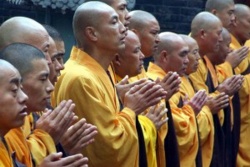Three schools of Buddhism
Introduced in India around 500 BC by Gautama, Buddhism swept quickly (some 1000 years) across Asia, splitting into three main schools (Theravada, Mahayana, Vajrayana) as it evolved. In India, its birthplace, Buddhism died out around 1200 AD, succumbing to Muslim invasions and resurgent Hinduism.
But by then it was flourishing in Southeast Asia, Tibet, China, Korea, and Japan -- it came last to Japan, crossing the sea around 520 - 550 AD. Although the Japanese court was quick to adopt Mahayana Buddhism, the teachings of the Theravada and the Vajrayana (Tantric or Esoteric) schools did not go unnoticed or unpracticed.
Sects from all three schools are still active in Japan today, but the dominant form is clearly Mahayana. This is especially true when talking about Buddhist sculpture and art. Many of Japan’s Buddhist treasures still survive and are available for firsthand inspection at temples in Nara, Kyoto, Kamakura, and elsewhere.
In large part, this artistic legacy tells the story of Mahayana Buddhism. Also, unlike the rigid atheism of Theravada Buddhism (which reveres the Historical Buddha but ignores all other deities), the Mahayana and Vajrayana schools brought with them a large number of Hindu deities (see TENBU) who were adopted into Japan’s Buddhist pantheon.
Buddhism in Japan subsequently developed along an extremely syncretic path, mixing together Hindu, Buddhist, and Shintō (kami cult) elements along with influences from Taoism, Confucianism, yin yang theories, zodiac cosmology, star worship, mountain asceticism, shamanism, nature cults, and animism.
